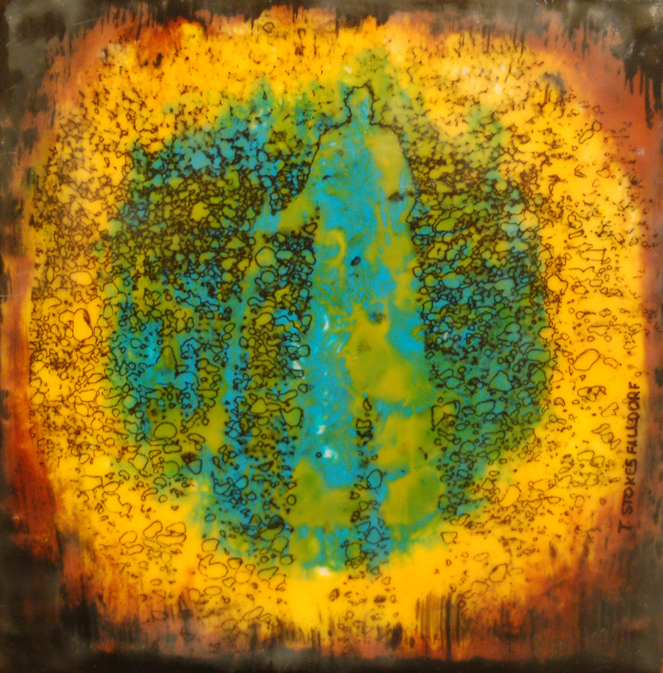In this gloomy winter, the media of encaustic evokes feelings of warmth both in its creation and appreciation.
Encaustic painting uses melted beeswax, resin and pigment. The word “encaustic” comes from the Greek word “enkaien,” meaning “to burn in,” and while encaustic isn’t literally torched into wood, encaustic must be kept warmed and molten while the artist works. Typically, an artist uses a hot plate — electric griddles work fine — with wax and pigment mixed on the palette and applied with a brush on wood or other rigid panels.
Through Feb. 5, “Part & Particle,” a show of encaustic and other wax art by members of AlaskaWax, is on display at the Ptarmigan Arts Backroom Gallery. AlaskaWax is a statewide organization of artists who support each other in painting using wax. Formerly known as AKIEA, the Alaska chapter of International Encaustic Artists, the group changed its name to reflect that some artists also work in the cold wax media.
“Part & Particle” is the Homer version of an AlaskaWax show displayed in September at Doriola’s, an Anchorage restaurant. While mostly Anchorage-area artists, the show includes work by longtime encaustic artist Kathy Smith of Homer and former Homer artist Laurel Epps. Epps curated the Ptarmigan show with Homer encaustic artist Kathy Drew.
Encaustic dates back to ancient Greece. Shipbuilders used beeswax to waterproof and caulk boats and added pigment to make designs. Egyptians used it to paint portraits on boxes holding mummified remains. When beeswax is mixed with tree resin like damar, the media becomes even more durable.
Encaustic can be used like paint, but it also can be reworked by heating with heat guns or small blowtorches. Layers of colors can be painted on top of each other, and then etched into, as Smith did with three pieces in the show, “Winter Ice I,” “Winter Ice II” and “Winter Ice III.”
“Having lots of layers is the key,” Epps said. “Start with lots of base layers. Put lots of layers on so you have something to go back into.”
Aside from using wax, “Part & Particle” works also follow another rule: they all had to be square. The Anchorage version of the show had panels no larger than 6-inches-by-6-inches, but the Homer show includes some larger square paintings. One piece consists of small panels that are part of a large image based on a photo of a pair of XtraTuf boots, “the XtraTuf challenge,” Epps called it. Artists also could use the full image, incorporating a photo transfer print.
That’s another technique encaustic uses — collage. A work by artist Dot Tideman uses rusty bits of metal. One of Epps’ works includes feathers. Photographs can be transferred to encaustic by rubbing a photo-transfer copy image, as was done in the XtraTuf paintings and by several works by Therese Stokes Falldorf of a photograph by Dennis Falldorf.
Epps got her start in encaustic after seeing a demonstration by Homer artist Ann-Margret Wimmerstedt and then later taking a class with Wimmerstedt. Artists need some specialized equipment like hot plates and good ventilation, but a lot of it can be improvised. Ventilation is important, since the wax particles can be toxic if breathed while being melted.
“You don’t want to be breathing those fumes,” Epps said.
Paints and the encaustic media of wax and damar can be expensive and hard to find. Homer Art and Frame sells encaustic materials. Some artists like Drew make their own media by mixing beeswax and damar together in thrift-shop crock pots.
Unlike oil or acrylic paints which are flexible, encaustic tends to be stiffer and can crack if painted on canvas. Most encaustic artists use wood panels. Epps had some clay tiles left over from other projects and used those. Sometimes artists paint clear encaustic media on a board as a base coat. Epps said she puts Venetian plaster on the wood and paints over that. A big fan of texture, Epps said she could have made the plaster smooth, but instead made it a bumpier, textured surface.
Smith said a technique she’s been trying is encaustic monoprinting, where encaustic is painted on a hard surface in various colors and designs. Using a press, that image is then printed on paper and mounted on a board.
A relatively new medium is cold wax, done more like painting in oils. Wisconsin artist Rebecca Crowell did a workshop in cold wax in August 2013 to coincide with her show of cold wax paintings, “Beneath the Surface,” displayed at the Pratt Museum. Like encaustic, cold wax often uses layering to create a work.
With its range of techniques and approaches, “Part & Particle” offers a good overview of the possibilities of encaustic and cold wax. The glow of the wax and the texture of the media takes the art beyond two dimensions. If as Marshall McLuhan said, the media is the message, then one message with encaustic might be “sit by the fire and warm up.”
The AlaskaWax group sponsors a workshop in both encaustic and cold wax with visiting artist Lisa Pressman in June and July at Stillpoint Lodge in Halibut Cove. The group also offers workshops in Anchorage as well as rents studio space — including materials — by the hour. For more information on AlaskaWax, visit its Facebook page by searching “AlaskaWax” or visiting www.facebook.com/pages/AlaskaWax/104695186283477.
Michael Armstrong can be reached at michael.armstrong@homernews.com.
Part & Particle
Where:
Ptarmigan Arts Back Room Gallery
When:
Through Feb. 5
Who:
Curated by
Laurel Epps and Kathleen Drew
Participating artists: Amy Hunt, Aracelis Bell, Cheryl Lyons, Dot Tideman, Gayla Ranf, Janaan Kitchen, Joyce Coolidge, Kathy Smith, Laurel Epps, Rivka-Chana Zorea, Ruth Carter and Therese Stokes Falldorf


